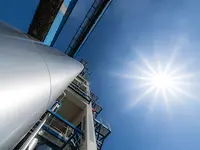Join us on a journey to tomorrow - transform your pulp mill into a full-scale biorefinery.
From biomass into new valuables
Look beyond pulp and achieve self-sufficiency in chemicals and energy. Expand your bio-based product portfolio to unlock new revenue streams while advancing sustainability. Partner with us to maximize your profitability and help other industries reduce their environmental footprint.
Side streams are by-products or waste streams generated during the main pulp production processes, which can be repurposed or converted into valuable products.
ANDRITZ technologies for side streams utilization include SulfoLoop sulfuric acid plant, which produces commercial-grade sulfuric acid from concentrated odorous gases and elemental sulfur, making the mill self-sufficient in sulfuric acid. Kraftanol biomethanol plant technology is designed to purify crude methanol into high-quality biomethanol.
For lignin recovery, ANDRITZ offers both the LignaRec and LigniOx processes. These innovative solutions recover high-quality lignin from black liquor in kraft mills. LignaRec focuses on efficient separation and purification for use in bio-based products, while LigniOx enables the production of functional lignin suitable for advanced applications such as adhesives, dispersants, and bioplastics. These novel technologies open new revenue streams through the valorization of lignin
ANDRITZ pulp mill technologies also offer other solutions for the production of advanced biochemicals. One example is microcrystalline cellulose (MCC), produced through specialized pulp processing. Another example is the pre-hydrolysis kraft pulping process, implemented with A-ConFlex™ pulping technology for flexible kraft or dissolving pulp production. This process enables the extraction of hydrolysate by-products such as xylose. These by-products can then be further processed into valuable chemicals such as furfural, xylitol, ethanol, and butanol.
ANDRITZ has pioneered advanced technologies that transform pulp mills into biorefineries, enabling the production of bio- and e-fuels from process side streams. Typical pulp mills have significant emissions of biogenic CO₂, which can be captured and converted into valuable products like e-fuels. ANDRITZ has also developed green hydrogen and carbon capture technologies and collaborates with other companies to enhance the synthesis processes for e-fuels.
Bark processing technologies are designed to maximize the value of bark left over from the pulp mill's debarking process. For example, the ANDRITZ HQ-Press bark press processes bark to achieve a higher dry solids content, increasing its net green energy value. These technologies help transform bark into a energy-dense biomass energy source for power boilers and gasifiers, contributing to sustainable and efficient energy production.
Bubbling Fluidized Bed (BFB), Circulating Fluidized Bed (CFB), and Grate boilers play crucial roles in the utilization of non-fossil fuels, particularly in biomass and waste-to-energy applications. Grate boilers – BioSol and FlexSol – are designed to burn solid fuels, including biomass, municipal solid waste, RDF and SRF, efficiently generating energy and reducing the amount of waste going into landfills. On the other hand, EcoFluid BFB boilers and PowerFluid CFB boilers offer high efficiency and versatility, capable of handling a wide range of fuels, including biomass and industrial waste.
ANDRITZ EnviroBurner multifuel solutions utilize industrial side streams, biofuels, and other sustainable fuels to generate green energy, thereby reducing the CO2 footprint of the main process.
The LimeBio-Powder lime kiln biofuel plant is designed to replace fossil fuels in lime kilns with biomass powder. This plant can handle various types of biomass, including forest residues, wood waste, and pellets.
Man-made cellulosic textile fibers are fibers derived from natural cellulose sources, such as wood pulp, through a chemical process. These fibers are functionally equivalent to natural fibers like cotton, offering a sustainable alternative for the textile industry.
ANDRITZ has been actively involved in the development and production of these fibers through various initiatives. One notable effort is the collaboration with Infinited Fiber Company to produce Infinna™, a high-quality fiber made from textile waste.
Another significant project is our partnership with Metsä Group on the Kuura textile fiber. This collaboration aims to develop a pulp pre-treatment method and integrate textile fiber production into bioproduct mills. The Kuura fiber is produced from Finnish wood without the use of fossil fuels
A-ConFlex™ cooking technology is a state-of-the-art solution developed by ANDRITZ that enables the production of high-quality dissolving pulp, which can then be used to produce viscose and lyocell fibers for textiles. This technology offers flexibility in the production process, allowing manufacturers to switch between kraft pulp and dissolving pulp based on market demand.
ANDRITZ is also involved in various textile recycling initiatives, focusing on both mechanical and chemical recycling processes to convert textile waste into new fibers, yarns, and nonwoven products.

UPM Paso de los Toros, the largest pulp mill in Uruguay and one of the largest in the world, produces 2.1 million tonnes of pulp annually and supplies approximately 1 TWh of surplus green electricity to the Uruguayan power grid.

CircleToZero initiative integrates advanced technologies and solutions to enable the creation of new valuable resources in the pulp and paper industry.





